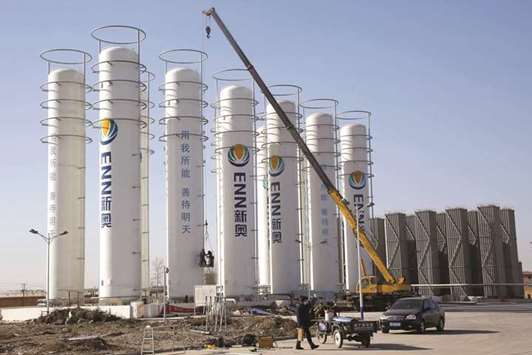China’s demand for natural gas is set for another winter boom, but this time around the world’s biggest energy user will be better prepared to deal with risks of shortages, according to Wood Mackenzie Ltd.
Less aggressive coal-to-gas switching, improved gas storage and a boost in imports will probably help China avoid a repeat of the heating crisis seen in the past winter, analyst Wen Wang said by phone from Beijing. Last year, infrastructure problems and fuel shortages idled factories and cut off heat to homes in the dead of winter.
The frantic effort to ensure gas supply underscores the balancing act China’s leaders are attempting to pull off as they enact policies to boost gas use in order to reduce coal smog from urban skies.
While Beijing has enjoyed some of the cleanest air in the past decade since such measures ramped up last summer, the country has become more reliant on imported gas and now risks tight supply situations during winter heating months.
“Winter is always going to be tight, and there is always going to be some shortages in terms of industrial users,” Wang said. “It’s probably OK for some factories to not be operating in the winter, but if people do not get heating in their homes, then that’s something else.
We don’t think we’re going to see that this winter.”
Policymakers are seen scaling back their goals for coal- to-gas conversions this year, targeting just 2mn households after forcing more than 4mn to switch last year, according to Wood Mackenzie.
Demand will still expand this winter, but at a more measured pace from last year, Wang said.
China’s top oil and gas producers have been laying the groundwork for this winter, including expanding storage capacity, raising prices and planning to keep liquefied natural gas cargoes on standby at sea to plug any gaps.
They’re also linking up pipelines and LNG terminals to ensure a smoother delivery of supply to users. About 40 % of additional gas demand could be met by increased storage capacity, a boost in pipeline imports and moderate growth in domestic production, Wang said.
That leaves the lion’s share of new demand to be satisfied by importing more LNG. China will purchase about 52mn to 53mn tonnes of overseas supply this year, up from 38mn last year and double the levels of 2016, Wang said.
The wild card is weather.
With China essentially having to max out its import capacity to bring in that amount of LNG, an extremely cold winter could knock its plans off balance and exacerbate shortages within the country, according to Wang.
Conversely, a milder winter might lead to a glut of imports and compel China to re-sell cargoes onto the global market, weakening spot prices that have risen to the highest level in about four years.
In any case, the biggest winners from the gas surge would be distributors such as ENN Energy Holdings Ltd and China Gas Holdings Ltd, according to Goldman Sachs Group Inc.
The bank recommended buying shares in the companies based on their ability to connect new customers, which would lead to an acceleration in earnings and cash flows, analysts including Mark Wiseman wrote in an August 31 note.

A liquefied natural gas storage facility under construction in Hebei Province, China. The country’s top oil and gas producers have been laying the groundwork for this winter, including expanding storage capacity, raising prices and planning to keep liquefied natural gas cargoes on standby at sea to plug any gaps. They’re also linking up pipelines and LNG terminals to ensure a smoother delivery of supply to users.


